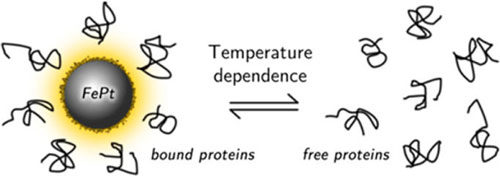| Posted: Jul 23, 2013 | |
Biological responses to nanoparticles are temperature-dependant |
|
| (Nanowerk Spotlight) When nanoparticles enter the human body, for instance as part of a nanomedicine application, they come into immediate contact with a collection of biomolecules, such as proteins, that are characteristic of that environment, e.g. blood. A protein may become associated with the nanomaterial surface during a protein-nanomaterial interaction, in a process called adsorption. The layers of proteins adsorbed to the surface of a nanomaterial at any given time is known as the protein corona (read more in our previous Nanowerk Spotlight: "Proteins interact with 'ultrasmall' nanomaterials in unique ways"). | |
| This protein coronas form a new surface on the nanoparticle that actually would be 'seen' by biological entities (e.g. cells) rather than the pristine surface of the synthesized nanoparticle itself. This is the reason why biological responses to nanoparticles are strongly dependent to the type and amount of associated proteins in the composition of the protein corona. | |
| The type and amount of proteins in the corona composition is strongly dependent on several factors, including physicochemical properties of nanoparticles; protein source; and protein concentration. However, the effect of temperature on the corona composition has not been investigated so far. | |
| In new work, reported in the July 1, 2013 online edition of ACS Nano ("Temperature: The 'Ignored' Factor at the NanoBio Interface"), researchers have conducted a comprehensive study to show the significant effect of temperature on corona composition. | |
| The multi-institutional team, led by Morteza Mahmoudi, a professor at Tehran University of Medical Sciences, who heads the Laboratory of Nano-Bio Interactions, and Wolfgang Parak, a professor at the University of Marburg, who heads the Biophotonics Group, investigated the influence of the exposure temperature, ranging from 5 to 45°C, on the formation and composition of the protein corona on magnetic nanoparticles as well as nanoparticle-cell interactions. | |
 |
|
| The results indicate that the degree of protein coverage and the composition of the adsorbed proteins on the nanoparticles' surface depend on the temperature at which the protein corona is formed. (Reprinted with permission from American Chemical Society) | |
| "Our findings are very important for the in vivo application of nanoparticle to humans," Morteza Mahmoudi, a researcher at the Nanotechnology Research Center at Tehran University of Medical Sciences, and first author of the paper, tells Nanowerk. "The mean body temperature for different individuals is in the range from 35.8 to 37.2 °C. Furthermore the temperature varies for different parts of the body and the body temperature of females is influenced by their hormonal cycle. During the sleep the body temperature decreases and manual work could lead to an increase. This means that the body temperature for healthy humans varies in the range from 35 to 39°C and can find a maximum of 41°C in the case of fever." | |
| "We have shown that changes in the incubation temperature can cause significant effects in protein corona formation and composition, although this is not necessarily always the case," he adds. "Temperature effects for the nanoparticles investigated by us were especially pronounced in the physiologically highly relevant temperature window of 37-41°C." | |
| The team hypothesized that, if protein adsorption onto the surface of nanoparticles depends on the body temperature, it may also result in a significant effect on the cellular uptake of nanoparticles in vivo. Therefore they also assessed the effect of the temperature-dependent corona composition on cellular uptake. They found, though, that their experimental data does not allow for deriving a sharp conclusion about the correlation between the temperature-dependence of protein corona formation and nanoparticle uptake. | |
| These findings indicate that one can expect to have different corona composition and, consequently, various biological responses to nanoparticles for specific sites – and specific situation – of the human body. | |
| "Our findings suggest that studies on the formation of a protein corona on nanoparticles should be carried out at well-controlled temperatures to enable comparison and reproduction of results from different laboratories," says Parak. "We expect our results to apply to other classes of nanoparticles, such as fluorescent or plasmonic nanoparticles, with similar surface functionalization, although we have not proved this yet experimentally." | |
| Furthermore, since the area of protein corona is still in its infancy, future work could be focused on potential ways to regulate corona composition in vivo. | |
 By
Michael
Berger
– Michael is author of three books by the Royal Society of Chemistry:
Nano-Society: Pushing the Boundaries of Technology,
Nanotechnology: The Future is Tiny, and
Nanoengineering: The Skills and Tools Making Technology Invisible
Copyright ©
Nanowerk LLC
By
Michael
Berger
– Michael is author of three books by the Royal Society of Chemistry:
Nano-Society: Pushing the Boundaries of Technology,
Nanotechnology: The Future is Tiny, and
Nanoengineering: The Skills and Tools Making Technology Invisible
Copyright ©
Nanowerk LLC
|
|
|
Become a Spotlight guest author! Join our large and growing group of guest contributors. Have you just published a scientific paper or have other exciting developments to share with the nanotechnology community? Here is how to publish on nanowerk.com. |
|
